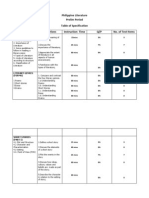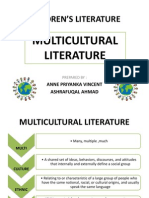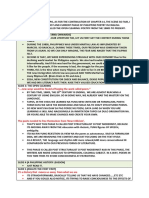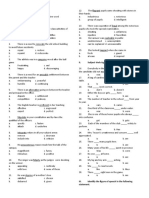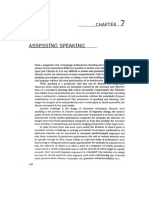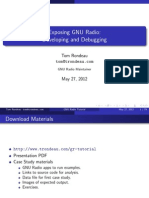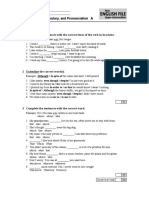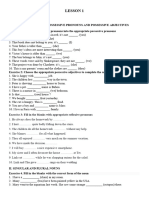Week 910 11 Module in Purposive Communication
Week 910 11 Module in Purposive Communication
Uploaded by
Jelaiza Thea FonteCopyright:
Available Formats
Week 910 11 Module in Purposive Communication
Week 910 11 Module in Purposive Communication
Uploaded by
Jelaiza Thea FonteOriginal Title
Copyright
Available Formats
Share this document
Did you find this document useful?
Is this content inappropriate?
Copyright:
Available Formats
Week 910 11 Module in Purposive Communication
Week 910 11 Module in Purposive Communication
Uploaded by
Jelaiza Thea FonteCopyright:
Available Formats
LEARNING MODULE IN PURPOSIVE COMMUNICATION
MR. KURT RUSSEL R. EUSTAQUIO
I. LEARNING OBJECTIVES
After reading this module the students would be able to:
identify the characteristics of academic writing by reading excerpts from academic papers;
write a paragraph using a register (language and style) appropriate to the academic context; and
practice high-level writing as a process of thinking, planning, reading, and evaluating, as well
as creating and revising knowledge for the benefit of Philippine society.
II. TIME FRAME
Week 9 – October 4 – 10, 2021
Week 10 – October 11 – 17, 2021
Week 11 – October 18 – 24, 2021
9 Hours
III. CHAPTER TOPICS
LESSON 1: ACADEMIC RESEARCH AND THE DOCUMENTED ESSAY IN THE 21 st CENTURY
LESSON 2: CRITICAL THINKING, COLLABORATION AND THE WRITING PROCESS
LESSON 3: CONCEPT OF SOCIAL AND CULTURAL SIGNIFICANCE IN TH PHILIPPINES
CHAPTER 3
THE DOCUMENTED ESSAY ON A CONCEPT
LESSON 1: ACADEMIC RESEARCH AND THE DOCUMENTED ESSAY IN THE 21 st CENTURY
Academic Writing- it is the presenting of ideas in a rational, organized, systematic, reasonable, and also in a
logic way.
Academic Writing Should Be:
Based on facts
Researched and not the writer’s opinion
Technically analyse the subject matter while taking previous research into account
Academic Writing Should Not Be:
Sound pompous
Difficult to read
Ungrammatical/Non-Standard/Informal
Process of Academic Writing:
Posing a question
Problematizing a concept
Evaluating opinion and ends with;
Answering the question
Clarifying the problem
Academic Discourse
- it involves how we alter our communication when engaged in academic discussions.
Examples: Textbook, Presentation, Research Articles, Lectures/Discussions, Essay Writing
Purpose of Academic Writing
Inform
Purposive Communication| MR. Kurt Russel R. Eustaquio Page 1 of 8
Argue
Persuade
Informal /Non-Standard Usages More Formal /Precise Equivalents
Alright, a lot, discuss, about, cope up with All right, a lot, result in, discuss, cope with
Good as is “good” book Entertaining, insightful, instructive
Can’t, won’t, she’s, I’ll, didn’t Cannot, will not, she is, I will did not
Gonna, gotta Going to, have to
Anyways, boring as hell, bored to death, major downer Anyway, boring or uninteresting, extremely bored,
depressing
I got here late: she got out of the office, he got a call, I arrived here late, she left the office, he received a
they got gas. call, they loaded gas or they refuelled
ASAP, BTW, SOP As soon as possible, by the way, standard operating
procedure
UP, ADMU, DLSU University of the Philippines, Ateneo De Manila
University, De La Salle University
Hit the sack, loo, comfort room Sleep, toilet/bathroom
Lol, adfk, nrn, #feels Laught out loud, away from keyboard, no reply
necessary, a wave of emotions
A Balanced and Credible Voice
- Besides using clear and specific languages, academic writing should not be stiff, or stilted and somber
tone.
- In academic writing, this means doing away emoting punctuation marks like exclamation points (!)
whether single multiple (!!!) and dramatic ellipses(…) used as a way of trailing off.
Cluttered Writing:
- I found the dulaang UP play Haring Lear (King Lear) to be not just entertaining, but also insightful
because I felt that the Tagalog translation effectively and humorously conveyed the spirit of Shakespeare
original dysfunctional family. To a contemporary Filipino audience.
Tighter Writing:
- The dulaang UP play Haring Lear (King Lear) was not just entertaining but insightful because the
Tagalog translation effectively and humorously conveyed the spirit of Shakespeare original
dysfunctional family to a contemporary Filipino audience.
Writer Focused:
- Our group conducted a survey on 100 University of the Philippines freshmen to find out their opinions
on the new academic calendar.
Focused on the Subject:
- A survey on 100 University of the Philippines freshmen to find out their opinions on the new academic
calendar.
Shifting to the Register of Academic Discourse
What would it be to go out on date with someone who talks like an academic paper?
Purposive Communication| MR. Kurt Russel R. Eustaquio Page 2 of 8
Without changing the content, rewrite the paragraph/s in register that is appropriate to the academe. A sample of
formal paragraph and revision are provided here for your reference.
Sample Informal Paragraph:
I usually go out to be relaxed and have fun. As a student, I go out to escape all the stress of school. Which is
why going out with someone who talks like a research paper wouldn’t be such a good thing. I will end up
getting bored, and still stuck, with the things I get enough of in school. It would end up in boredom instead of
fun and excitement.
Sample Revision
People typically engaged in dating activities in order to relax and to enjoy themselves. For students, dating is an
escape from their hectic academic lives. Thus, if one’s date turns out be a person who talks like a research
paper, the purpose of the activity will be defeated. These experience would be neither engaging nor interesting
because one would be faced with dreaded academic topics and discussions. Essentially, the date will be a
tedious rather than enjoyable one.
Socially and Culturally Relevant Topic
- One final important myth to debunk is academic papers deals with topics that are likely to bear both the
writers and the reader.
- In reality, students writer are often allowed to select their own topic within a more general area specified
by the teachers, the course and the discipline.
DOCUMENTED ESSAYS
Academic suggests more than just the style and tone of writing.
Documented Essay/Academic Papers essential aspect is the credibility and its contribution to scholarly
studies.
Documented essay – is another term for “academic paper”; here, the term “documented” emphasizes that any
kind of scholarly or academic writing requires the writer to (1) read and gather information from a variety of
relevant sources on a chosen topic (2) clearly these supporting sources, and (3) add to scholarship by selecting,
arranging, commenting on, or even debunking the information these sources.
Writers are required to:
1. To read and gathered information from a variety of relevant sources on a chosen topic.
2. Clearly acknowledge the supporting sources.
3. Add to scholarship by selecting, arranging, commenting on, or even debunking the information from the
sources.
Documented Essays vs. Standard Essays
1. Both consist of an introduction with explicitly stated argument/thesis, three or more supporting
paragraphs and conclusion.
Standard Essay – generally known facts, personal experiences of the writer.
Documented Essay- requires concrete supporting information from a relevant sources.
2. Failure to properly cite a source results in the Deadliest of Academic sins: PLAGIARISM
Plagiarism
1. Do not plagiarise.
2. Plagiarism is once you borrowed someone else words and make these appear as your own.
3. When a person copies word for word, a sentence, paragraph, a whole article, a section of book, or different
sections of long article or book written by marks.
4. When a person borrows someone else ideas, rewards them to make ideas seem like his/her own.
5. When a person translate to Filipino or other Philippine languages someone else ideas that were expressed in
English or other foreign languages and fails to be enclose the translated material in quotation marks.
Purposive Communication| MR. Kurt Russel R. Eustaquio Page 3 of 8
6. Even when a person frames the ideas of a writer in another way or in different language, and conveniently
forgets to acknowledge the source of the ideas that still constitutes plagiarism.
7. There is nothing wrong in borrowing an author’s ideas. We encourage students to research the wealth of
materials in booms or the internet to expand their knowledge and bolster their own critical position. But we
never should forget or fail to give recognition of who inspired us, whose conceptual framework we found
applicable to our research, or whose powerful ideas stirred us to develop our own.
8. I summarized my lecture on plagiarism with one Filipino word KATAPATAN.
9. I liken a plagiarism to a mother who borrows a ganta of rice from a neighbour and forgets that what saved her
family for the day was kindness of the neighbour.
Tell-tale signs of Plagiarism:
10. A plagiarist always leaves behind a trail of tell tale signs.
11. The trail begins with just a turn of phrase without quotation marks. As human being, we think a like but we
develop and express our ideas in our own individual styles.
12. The students may become desperate and so surfs for an article in the internet in the website she/he thinks is
obscure enough.
13. A political science professor, for instance, had half of her class submitting an assignment with exactly the
same wordings.
14. Some students are not clever in plagiarizing.
15. We would like to think that graduate students would already have attained sufficient maturity and
independence of thinking and would likely not commit plagiarism.
16. In UP we have been known to remove our faculty roll a teacher who copied an American textbook and
simply change the American names to Filipino names.
Effects of Plagiarism:
17. Borrowing is not a crime. This is a statement in repeat over and over but; always warn them to never fail use
quotation mark and foot note or end note.
18. Why do students copy? It begins in the way of student in the elementary and high school are trained for lack
of information.
19. For undergraduate students, I believe that their plagiarism is born more out of desperation intent.
20. Why do I said against? It is because claiming another one’s word dishonest.
21. KATAPATAN is all that required to keep us our integrity and dignity intact.
Writing a Document Essay and Avoiding Plagiarism
Plagiarism is actually easily avoided by finding out how to properly “borrow” someone else word of idea.
Example on how to avoid plagiarism:
Paraphrase – read it and put it into your own words. Make sure that you did is not copying.
Cite – citing is one of the effective ways to avoid plagiarism follow the document formatting guidelines.
Quoting – when quoting a source, use the exactly the way it appears.
Citing quotes- citing a quote can be different by citing paraphrased materials.
Reference – one of the most important ways to avoid plagiarism is including reference page or page of work
cited at the end of the research paper.
Three Essential Element of Attribution:
In text or parenthetic citation
A list of work cited, an attribution
Reference to all author or title of the source and it necessary brief information to the discussion.
At the end of the paper must list all sources that have been cited or mentioned
Bibliographic information about these sources will appear in alphabetically arranged list of work cited.
Purposive Communication| MR. Kurt Russel R. Eustaquio Page 4 of 8
The following information is required:
1. Author’s name
2. Title of the text
3. Publication place
4. Publisher
5. Publication
LESSON 2: CRITICAL THINKING, COLLABORATION AND THE WRITING PROCESS
WRITING AS A PROCESS
In 1992, an educator and journalist named Donald M. Murray proposed that teachers should “Teach Writing
as a process not a Product.” This means that writing consists of more than just drafting a paper but rather as
three stages that Murray calls pre-writing, writing, rewriting.” (1972)
The following sections introduce and explain the three stages of the writing process as well as component of
these stages.
1. The Pre-writing Stage Of the Writing Process
The pre-writing stage is defined as “everything that takes place before the first draft” (Murray, 1972).
CHOOSING A TOPIC AND LIMITING IT
ASKING RESEARCH QUESTIONS AND ESTABLISHING THE SIGNIFICANT OF ONE’S
RESEARCH
COMPOSING A THESIS STATEMENT
PREPARING A WRITING OUTLINE
DOING RESEARCH AND FINDING CREDIBLE SOURCES
2. The Writing Stage of Writing Process
The second stage of writing process. This is writing or “The act or producing a first draft”. Which Donald
Murray (1973) says is the “fastest” part of the writing process, taking up as little as 1% of writers time. That’s
because if the essay is well planned, drafting will not be difficult. Moreover, the product of drafting is only an
initial draft.
According to Educator Murray Suid and Wanda Lincoln (1989) writing of drafting is “Like making a sketch for
painting: paint’s doesn’t worry about getting all the lines perfect the first time”. Similarly the writer does not
expect to get all the words and information right in the first draft.
3. The Rewriting Stage of the Writing Process
The third involves “researching, rethinking, redesigning, rewriting, and finally, line by line editing, the
demanding, satisfying process of making every word right” (Murray 1972). In this stage, the writer reviews the
paper to see how it may be improved asking questions such as:
Is the title appropriate and effective?
Is the first paragraph interesting and compelling? Is it related to the topic?
Does the introduction include a clearly stated main idea?
Are transitions and connections between ideas smooth and signed clearly?
What needs to be added, omitted, or organized?
Is there anything confusing or unclear in the content of the essay?
What should be edited in properly acknowledged via in-text citations and bibliographic list?
Have all sources properly acknowledged via in-text citations and bibliographic list?
Purposive Communication| MR. Kurt Russel R. Eustaquio Page 5 of 8
In many writing classes, the writing stage becomes collaborative, not just when the instructor gives the student
writer feedback, but also when student read one another’s essay and comments on these in a workshop or peer
review. It is ideal to get concrete feedback from more than one reader on aspects of content, grammar,
mechanics, documentation and style, so that later drafts benefit from readers suggestions.
LESSON 3: CONCEPT OF SOCIAL AND CULTURAL SIGNIFICANCE IN THE PHILIPPINES
The final lesson focuses more specifically on how to write a document essay on a concept paper of social and
cultural significance. In this final lesson, you will apply what you learned in the two previous lesson to write a
documented essay on a concept of social and cultural significance, which you will read to represent to your
peers.
WRITING ABOUT CONCEPTS
The term “concept” is a synonym for an idea, motion or thought. More importantly thought, “concept” may
also refer to a perception, conception, or impression of something– a theory or perspective about something
Before Reading Task
1. Consider what you think of the term “concept”. Do a free-writing exercise in which you try to define the
word (A free-writing exercise is when you are told to write anything that comes to mind connected to the word
“concept”. This means that you should keep your pen continuously moving for ten minutes without censoring
yourself.)
2. After you have come up with your own overall definition of “concept” look up the definition from three
different credible source of the term “concept”. Don’t forget to jot down bibliographic source information.
3. Then write one of documented paragraph that explains what “concept” means from both and others that you
would enjoy writing about, especially concepts relevant to Filipinos like you.
Sample of Concept Paper
Pinoy Baduy
Doreen Fernandez
Doreen Fernandez’s “Pinoy Baduy,” originally published in Who Magazine in 1982, is available online via
Budhi: A Journal of Ideas and Culture (2002), specifically Volume 5, Issue, 36.1. Fernandez draws on variety of
sources and examples to talk about the meaning of the expression “baduy.” As the title suggests, she finds a
connections between this label and the “truly Pinoy” experience. For instance, she mentions links between
“baduy” practices of bringing pasalubong and the more general Filipino trait of being accommodating even
“overly accommodating” (Fernandez, 2002). Fernandez also, quite significantly, links the label to attitudes
relating to class and the wealthy Western world. The full text may be read here:
http://journals.ateneo.edu/ojs/index.php/budhi/article/view/601/598.
While-Reading Questions:
1. What is the author’s central thesis or overall definition of the term “baduy”? How does this relate to
the essay’s title?
2. How did the author extend the definition of the concept?
Choose the following:
a. Definition, that is, basic neutral definitions from the dictionary or other reference materials and connotations
or more emotionally laden meanings of the concept according to various sources.
b. Tracing of the etymology or origin of the concept/term
c. Narration or the use of the story or anecdote to explain the concept
d. Description of the concept or of people/places/objects to which the concepts is applied
Purposive Communication| MR. Kurt Russel R. Eustaquio Page 6 of 8
e. Exemplification or examples that illustrate the concept
h. Analysis of cause and effect, that is, reasons for and implications of the concept’s existence.
i. Negation or the explanation of what the term is not , perhaps by looking at the opposite of what it means
j. Related terms of synonyms of the concept
3. Which specific development points did you find particularly effective? Why?
4. Was the concept clearly defined? Why or Why not?
5. Do you agree with the overall definition? Why or Why not?
6. Since the term is an old one, are there new terms that mean the same thing in today’s society? What
are they?
7. What was the conclusion of the author? Do you agree with the conclusion?
After-Reading Tasks
Is the concept of being baduy one of social and cultural significance? Why or Why not?
Do you think that the definition provided by Fernandez is still relevant today?
Consider some contemporary class-related like terms “jolog”, “jejemon”, and “conyo” and free-write about the
basic definition, interesting examples, and the larger significant of any these terms. What do they reflect about
Philippine and society?
IV. COMPREHENSION CHECK UP
Pass the assessment according to the given day and time. Failure to pass on time is considered as 0.
Teacher’s Note: Your answer must be handwritten in a clean bond paper and will be submitted to the
instructor’s messenger account. Take a photo and submit it to me right away.
Direction: Answer the following questions
WEEK 9 ASSESSMENT
Deadline of submission will be on October 8, 2021 - 8:00AM only
1. What is your understanding of the term “plagiarism”? Try defining this in your own words.
2. Look up the meaning of the Filipino word “katapatan”. Explain in English what this word means.
WEEK 11 ASSESSMENT
Deadline of submission will be on October 22, 2021 - 8:00AM only
1. What does the word “baduy” mean to you?
2. How would you describe the clothing and behavior of a person you would label as “baduy”?
3. Do you know any other terms whose meaning is related to baduy?
Checked by:
Purposive Communication| MR. Kurt Russel R. Eustaquio Page 7 of 8
LORETA JANDUSAY, MBA
HM Department Head
Purposive Communication| MR. Kurt Russel R. Eustaquio Page 8 of 8
You might also like
- Devanshi Jadeja - Figurative - Language.01No ratings yetDevanshi Jadeja - Figurative - Language.013 pages
- Test Questions On Position Papers Blooms Taxonomy Edition 10 ItemsNo ratings yetTest Questions On Position Papers Blooms Taxonomy Edition 10 Items3 pages
- (Benet) Final Examination Literary CriticismNo ratings yet(Benet) Final Examination Literary Criticism2 pages
- SURVEY OF PHILIPPINE LIT. IN ENGLISH 3rd SET WRKSHTNo ratings yetSURVEY OF PHILIPPINE LIT. IN ENGLISH 3rd SET WRKSHT3 pages
- Positioning P He in Four Discourse Quadrants100% (1)Positioning P He in Four Discourse Quadrants21 pages
- Czogct9ze - GE 12 Lit 1 Lesson 1 Introduction To LiteratureNo ratings yetCzogct9ze - GE 12 Lit 1 Lesson 1 Introduction To Literature21 pages
- Faith, Love, Time, & Dr. Lazaro - Worksheet No.3No ratings yetFaith, Love, Time, & Dr. Lazaro - Worksheet No.32 pages
- I. Multiple Choice. Write The Letter of Your Choice.: Critical Reading and Writing Skills First SemesterNo ratings yetI. Multiple Choice. Write The Letter of Your Choice.: Critical Reading and Writing Skills First Semester2 pages
- Revised Summative Test Based On TOS English 6 ANo ratings yetRevised Summative Test Based On TOS English 6 A4 pages
- Lesson 4 Parts of The Campus Paper and NewspaperNo ratings yetLesson 4 Parts of The Campus Paper and Newspaper44 pages
- 2 Lesson Plan in Reading and Writing Grade 11No ratings yet2 Lesson Plan in Reading and Writing Grade 115 pages
- (M5 MAIN) 21st Century Literature From The PhilippinesNo ratings yet(M5 MAIN) 21st Century Literature From The Philippines55 pages
- Sto. Niño College of Ormoc Incorporated: Doña Feliza Mejia Village Ormoc City, Leyte0% (1)Sto. Niño College of Ormoc Incorporated: Doña Feliza Mejia Village Ormoc City, Leyte5 pages
- September 3 Colonialisms and CosmopolitanismsNo ratings yetSeptember 3 Colonialisms and Cosmopolitanisms4 pages
- Summative Test No. 1 Creative Non-FictionNo ratings yetSummative Test No. 1 Creative Non-Fiction3 pages
- MODULE 4 WEEK 12 LESSONs 1and 2 Writing A Book Review or Article Critique and Literature ReviewNo ratings yetMODULE 4 WEEK 12 LESSONs 1and 2 Writing A Book Review or Article Critique and Literature Review9 pages
- Module 1 (Survey of Phil. Lit. in English)No ratings yetModule 1 (Survey of Phil. Lit. in English)7 pages
- Module 1: A Rediscovery of The Literary World Reflect UponNo ratings yetModule 1: A Rediscovery of The Literary World Reflect Upon4 pages
- A Study Guide for Walter Raleigh's "The Nymph's Reply to the Shepherd"From EverandA Study Guide for Walter Raleigh's "The Nymph's Reply to the Shepherd"No ratings yet
- Download Full (Ebook) Libraries before Alexandria: ancient near eastern traditions by Barjamovic, Gojko;Ryholt, K. S. B ISBN 9780199655359, 0199655359 PDF All Chapters100% (14)Download Full (Ebook) Libraries before Alexandria: ancient near eastern traditions by Barjamovic, Gojko;Ryholt, K. S. B ISBN 9780199655359, 0199655359 PDF All Chapters40 pages
- DanielIyabodeOm 2011 CHAPTERTHREE IntroductoryPhoneticsNo ratings yetDanielIyabodeOm 2011 CHAPTERTHREE IntroductoryPhonetics15 pages
- A Complete Guide To Flexbox - CSS-Tricks PDFNo ratings yetA Complete Guide To Flexbox - CSS-Tricks PDF533 pages
- Matlab: Am and FM Modulation: Experiment NumberNo ratings yetMatlab: Am and FM Modulation: Experiment Number2 pages
- Test Questions On Position Papers Blooms Taxonomy Edition 10 ItemsTest Questions On Position Papers Blooms Taxonomy Edition 10 Items
- SURVEY OF PHILIPPINE LIT. IN ENGLISH 3rd SET WRKSHTSURVEY OF PHILIPPINE LIT. IN ENGLISH 3rd SET WRKSHT
- Czogct9ze - GE 12 Lit 1 Lesson 1 Introduction To LiteratureCzogct9ze - GE 12 Lit 1 Lesson 1 Introduction To Literature
- I. Multiple Choice. Write The Letter of Your Choice.: Critical Reading and Writing Skills First SemesterI. Multiple Choice. Write The Letter of Your Choice.: Critical Reading and Writing Skills First Semester
- (M5 MAIN) 21st Century Literature From The Philippines(M5 MAIN) 21st Century Literature From The Philippines
- Sto. Niño College of Ormoc Incorporated: Doña Feliza Mejia Village Ormoc City, LeyteSto. Niño College of Ormoc Incorporated: Doña Feliza Mejia Village Ormoc City, Leyte
- MODULE 4 WEEK 12 LESSONs 1and 2 Writing A Book Review or Article Critique and Literature ReviewMODULE 4 WEEK 12 LESSONs 1and 2 Writing A Book Review or Article Critique and Literature Review
- Module 1: A Rediscovery of The Literary World Reflect UponModule 1: A Rediscovery of The Literary World Reflect Upon
- A Study Guide for Walter Raleigh's "The Nymph's Reply to the Shepherd"From EverandA Study Guide for Walter Raleigh's "The Nymph's Reply to the Shepherd"
- Download Full (Ebook) Libraries before Alexandria: ancient near eastern traditions by Barjamovic, Gojko;Ryholt, K. S. B ISBN 9780199655359, 0199655359 PDF All ChaptersDownload Full (Ebook) Libraries before Alexandria: ancient near eastern traditions by Barjamovic, Gojko;Ryholt, K. S. B ISBN 9780199655359, 0199655359 PDF All Chapters
- DanielIyabodeOm 2011 CHAPTERTHREE IntroductoryPhoneticsDanielIyabodeOm 2011 CHAPTERTHREE IntroductoryPhonetics








